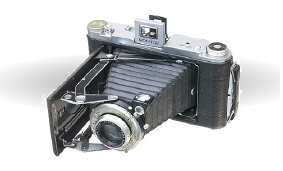 |
|||||
| The Kodak Monitor was
the end point of Kodak's line of folders with flipup finders. It was also
the heaviest and about the same dimensions as the later Tourist. Monitors
were made in several models with the primary differences being the quality
of lenses and shutters and film size--monitors were made for 620 and for
616 film. There were other minor differences that followed price points.
Monitors were distinguished from other Kodak folders made in the 40s by having more advanced film handling. While they still had the ruby window, they also had a toothed roller that drove a film counter that registered frames on a dial atop the camera. This added about 3/8-inch to camera height, making the Monitors taller than the Kodak Juniors, Seniors. Vigilants and Special 620. Monitors had a body release, but in my experience, it is less reliable than a similar arrangement on the Kodak Senior. The Monitor's release sometimes hangs up because the linkage doesn't get positioned right when the camera is opened; early Monitors seem more prone to this than later ones. The Monitor's flipup finder has good quality optics and is generally brighter than enclosed finders, like the one on the Tourist. Vigilants were essentially monitors without the advanced film handling. Seniors and Specials were a generation earlier, but often have similar lenses and shutters. Of course the Monitor's biggest
deficiency is that it lacks a rangefinder, not trivial on the 616 model
with a 126mm lens. There is a workaround for this problem, though not
the equivalent of a coupled rangefinder. Kodak and many small German manufacturers
made accessory rangefinders that slipped into the accessory shoe. All Monitor optics were scale focusing
and were the highest quality lenses and shutters on Kodak folders. These
were Kodak Anastigmat and Kodak Anastigmat Specials Both the Monitor and Vigilant, as
well as the earlier Special, Junior and Senior folders were made in 616
models, and as current day users, these cameras provide an attractive
capability--a negative that measures 2 1/4 x 4 1/4--that
provides a moderate panoramic format. While earlier Kodak folders were
commonly available for rollfilm sizes that produced images of 4 x 5, modern
bulk rollfilm to respool these sizes would be a custom product, so the
616 folders are, in some sense, the last of the large format folders.
Spooled film for 616 has been long discontinued, but that impediment can
be managed by rolling 70mm bulk film onto 616 spools with 616/116 backing
paper As noted on the Tourist page, finding a folder that suits you is a matter of tradeoffs. As Chris Perez notes in his tradeoff analysis, while a used Mamiya 6 costs about $19/line/mm, his used Kodak Special 620 with an uncoated Anastigmat Special cost about two orders of magnitude less-- $0.23/line/mm. This is in a package that weighs a little over a pound and, closed, is a little larger than a Leica M4. |
|||||
. |
||||
 12/27/2010 0:40 |  | ||||